CEEESA Power Systems Analysis Tools
The Center for Energy, Environmental, and Economic Systems Analysis (CEEESA) provides power systems analysis tools that cover a wide range of issues. The table below summarizes the available models. Click on each model name to get more information.
| Deregulated power market analysis |
GTMax, EMCAS, SMN, Power Market Simulator |
| Reliability analysis |
ICARUS, WASP |
| Capacity expansion analysis |
WASP, APEX, PACE, DECADES |
| Electricity demand forecasting and analysis |
MAED |
| Optimizing of hydropower resources |
APS, PC-VALORAGUA |
| Production cost analysis |
ICARUS, PC-VALORAGUA |
| Marginal cost analysis |
WASP, ICARUS, PC-VALORAGUA |
| Interconnections and power pools |
GTMax, SMN, PC-VALORAGUA |
| Transmission analysis |
ALF |
Generation and Transmission Maximization (GTMax)
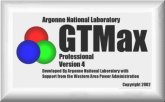 The GTMax model helps researchers study complex marketing and system operational issues. With the aid of this comprehensive model, utility operators and managers can maximize the value of the electric system, taking into account not only its limited energy and transmission resources, but also firm contracts, independent power producer (IPP) agreements, and bulk power transaction opportunities on the spot market. The GTMax model helps researchers study complex marketing and system operational issues. With the aid of this comprehensive model, utility operators and managers can maximize the value of the electric system, taking into account not only its limited energy and transmission resources, but also firm contracts, independent power producer (IPP) agreements, and bulk power transaction opportunities on the spot market.
GTMax maximizes net revenues of power systems by finding solutions that increase income while minimizing expenses. At the same time, the model ensures that market transactions and system operations remain within the physical and institutional limitations of the power system. When multiple systems are simulated, GTMax identifies utilities that can successfully compete in the market by tracking hourly energy transactions, costs, and revenues.
An added benefit of GTMax is that it simulates some limitations, including power plant seasonal capabilities, limited energy constraints, transmission capabilities, and terms specified in firm and IPP contracts. Moreover, GTMax also considers detailed operational limitations, such as power plant ramp rates and hydropower reservoir constraints. Currently, power companies are using GTMax to determine hourly, weekly, and seasonal power and energy offers to customers and to compute the costs of environmental legislation. GTMax can also be used to fine-tune hourly resource generation patterns, spot market transactions, energy interchanges, and power wheeling on the transmission system. Click here for more details on GTMax.
For more information about Generation and Transmission Maximization (GTMax), contact CEEESA.
Electricity Market Complex Adaptive System (EMCAS)
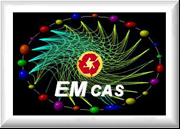 CEEESA's new EMCAS model is based on a novel agent-based simulation and modeling (ABMS) approach. ABMS allows analysts to represent the diverse set of participants in the electricity market as individual “agents.” All agents have their own set of objectives, decision-making rules, and behavioral patterns. Further, agents can draw on an array of historic information (e.g., past power prices) and projected data (e.g., next-day weather) to support their unique decision processes. CEEESA's new EMCAS model is based on a novel agent-based simulation and modeling (ABMS) approach. ABMS allows analysts to represent the diverse set of participants in the electricity market as individual “agents.” All agents have their own set of objectives, decision-making rules, and behavioral patterns. Further, agents can draw on an array of historic information (e.g., past power prices) and projected data (e.g., next-day weather) to support their unique decision processes.
Unlike conventional electric system models, the ABMS techniques in EMCAS do not postulate a single decision maker with a single objective for the entire system. Rather, agents are allowed to establish their own objectives and apply their own decision rules. The complex adaptive systems (CAS) approach empowers many agents to learn from their previous experiences and change their behavior when future opportunities arise. That is, as the simulation progresses, agents can adapt their strategies based on the success or failure of previous efforts. Genetic algorithms are used to provide a learning capability for certain agents. Click here for more details on EMCAS.
For more information about Electricity Market Complex Adaptive System (EMCAS), contact CEEESA.
Power Market Simulator
 The Power Market Simulator can be run in either a spreadsheet environment or within CEEESA's Generation-Transmission Maximization (GTMax) model. While in the simulator, real people represent power generation companies submitting hourly generation bids into a virtual market. In CEEESA's Electricity Markets Complex Adaptive Systems (EMCAS) model, simulated agents submit these bids. Bids are submitted for 24-hour periods (day-ahead market) and entered into the model. The software is then run to determine market clearing prices, generation levels for all units, and profits/losses for each market participant. Before starting the simulation, each participant is provided with a set of "market rules" that have to be followed by each player. Click here for more information on the power market simulator. The Power Market Simulator can be run in either a spreadsheet environment or within CEEESA's Generation-Transmission Maximization (GTMax) model. While in the simulator, real people represent power generation companies submitting hourly generation bids into a virtual market. In CEEESA's Electricity Markets Complex Adaptive Systems (EMCAS) model, simulated agents submit these bids. Bids are submitted for 24-hour periods (day-ahead market) and entered into the model. The software is then run to determine market clearing prices, generation levels for all units, and profits/losses for each market participant. Before starting the simulation, each participant is provided with a set of "market rules" that have to be followed by each player. Click here for more information on the power market simulator.
For more information about Power Market Simulator, contact CEEESA.
Model for Analysis of Energy Demand (MAED)
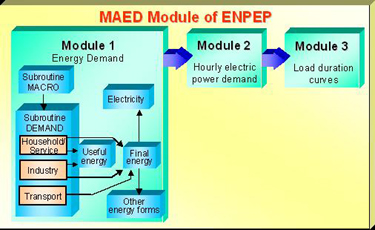 Described as a strategic, scenario-based, simulation model, MAED performs long-term energy and electricity demand forecasting. Future energy demand is estimated by using a bottom-up approach in which useful energy demands for specific activities are projected. Energy consumption levels for individual activities are then aggregated to project total future demand for fossil fuels, electricity, district heating, coke, and feedstocks in each sector/subsector of the economy. Described as a strategic, scenario-based, simulation model, MAED performs long-term energy and electricity demand forecasting. Future energy demand is estimated by using a bottom-up approach in which useful energy demands for specific activities are projected. Energy consumption levels for individual activities are then aggregated to project total future demand for fossil fuels, electricity, district heating, coke, and feedstocks in each sector/subsector of the economy.
Designed to reflect the structural changes in energy demand, MAED performs detailed analyses of social, economic, and technological developments, as well as policy issues. The latest version is spreadsheet-based and offers much more flexibility in defining a country’s energy system representation. MAED is distributed by the International Atomic Energy Agency. Argonne provides technical support.
For more information about Model for Analysis of Energy Demand (MAED), contact CEEESA.
Wien Automatic System Planning Package (WASP)
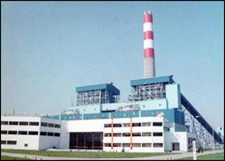 This widely used model analyzes generating system expansion options, primarily to determine the least costly expansion path that will adequately meet the demand for electric power, subject to user-defined constraints. To measure the economic performance of alternate expansion plans, WASP uses the present value of total system costs, including the capital cost of new generating units, fixed/variable operation and maintenance costs, fuel costs, and costs of unserved energy. This widely used model analyzes generating system expansion options, primarily to determine the least costly expansion path that will adequately meet the demand for electric power, subject to user-defined constraints. To measure the economic performance of alternate expansion plans, WASP uses the present value of total system costs, including the capital cost of new generating units, fixed/variable operation and maintenance costs, fuel costs, and costs of unserved energy.
Probabilistic simulation is used to calculate the production costs and reliability parameters for numerous possible future system configurations. A dynamic programming technique is used to determine an economically optimal expansion path for the electric power system under consideration. System reliability is evaluated on the basis of three indices: reserve margin, loss-of-load-probability, and unserved energy. These indices, along with the maximum number of thermal or hydroelectric units that can be added each year, are user-specified constraints required for acceptance of an expansion plan.
WASP’s modular structure permits users to monitor intermediate results during the iterative optimization process. A new Windows version (WASP-IV) is now available. WASP-IV considers pumped-storage plants; allows specification of a fixed maintenance schedule for units in the system; computes atmospheric emissions; and introduces new constraints on total emissions, fuel consumption, and electricity generation. WASP was developed and is distributed by the International Atomic Energy Agency. Argonne provides technical support.
For more information about Wien Automatic System Planning Package (WASP), contact CEEESA.
Database and Methodologies for Comparative Assessment of Different Energy Sources for Electricity Generation (DECADES)
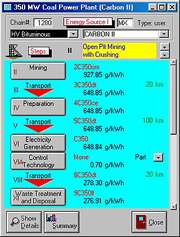 Developed and distributed by the International Atomic Energy Agency, the DECADES software tools include the DECPAC model, which integrates electric system expansion planning with the analysis of primary energy supply chains and computes the resulting environmental emissions. Developed and distributed by the International Atomic Energy Agency, the DECADES software tools include the DECPAC model, which integrates electric system expansion planning with the analysis of primary energy supply chains and computes the resulting environmental emissions.
The model provides several levels of analysis (e.g., power plant, fuel chain, and electric power system) and facilitates a comparative assessment of different energy sources for generating electricity. The DECADES databases include the Reference Technology Database (RTDB), the Country Specific Database (CSDB), the Toxicology Database (TOXDB), and the Health and Environmental Impacts of Energy Systems (HEIES) database. Argonne’s training programs and technical expertise support the use of this software.
The DECPAC module of DECADES generally follows the same analytical procedure as WASP, but its computational routine is simplified. Users evaluate not only electric power generation technologies, but also the fuel supply chain for each technology. DECPAC allows comparative analyses of alternative power generation technologies. Developed and distributed by the International Atomic Energy Agency. Argonne provides technical support.
For more information about Database and Methodologies for Comparative Assessment of Different Energy Sources for Electricity Generation (DECADES), contact CEEESA.
Argonne Production, Expansion, and Exchange (APEX) Model for Electrical Systems
 APEX integrates several modules that are used to evaluate production costs, reliability, transmission, and expansion alternatives for electric utilities. These modules are set up to transfer data among themselves. User‑friendly menu systems allow for information input and evaluation of results. Each of the APEX modules shown in the figure to the left is discussed below. APEX integrates several modules that are used to evaluate production costs, reliability, transmission, and expansion alternatives for electric utilities. These modules are set up to transfer data among themselves. User‑friendly menu systems allow for information input and evaluation of results. Each of the APEX modules shown in the figure to the left is discussed below.
For more information about Argonne Production, Expansion, and Exchange (APEX) Model for Electrical Systems contact CEEESA.
Investigation of Cost and Reliability in Utility Systems (ICARUS)
The ICARUS module is an energy-system planning tool that assesses the reliability and economic performance of alternative expansion patterns of electric utility generating systems. This detailed dispatch model calculates (1) a system maintenance schedule (if not fully specified), (2) system loss-of-load probability, (3) unserved demand for electric energy, (4) reserve capacity needed to meet a specified reliability criterion, (5) effects of emergency interties, (6) expected energy generation from and cost of each unit and block, (7) total generating system costs, and (8) fuel use.
The simplified probabilistic simulation technique provided by ICARUS significantly reduces computational requirements. Its calculations are based on system loads, unit-level generating resources, system operational constraints, and capacity and energy transfers among utility systems.
For more information about Investigation of Cost and Reliability in Utility Systems (ICARUS), contact CEEESA.
Production and Capacity Expansion Model (PACE)
The PACE model in APEX is a dynamic program used to determine long-term utility capacity expansion schedules. New units are added on the basis of existing supply resources, candidate technologies, load growth estimates, and long-term firm contracts. The model also expands system capacity so that reliability constraints are not violated.
PACE uses the ICARUS model to estimate unit-level generation, production costs, and system loss-of-load probabilities for possible capacity expansion paths. The model then uses these costs, along with the costs of capital investments and fixed operations and maintenance, to estimate the least-cost expansion path and suboptimal expansion paths.
For more information about Production and Capacity Expansion Model (PACE), contact CEEESA.
Spot Market Network Model (SMN)
 The SMN multipurpose power network analysis tool can be used for a wide range of applications. At a relatively high level of aggregation (e.g., company level), the model determines the level of economic energy transactions between utility companies so that overall costs are minimized. At a finer level of detail (e.g., unit level), the SMN determines the optimal dispatch of units, while considering unit-level operational restrictions and transmission limitations. The SMN multipurpose power network analysis tool can be used for a wide range of applications. At a relatively high level of aggregation (e.g., company level), the model determines the level of economic energy transactions between utility companies so that overall costs are minimized. At a finer level of detail (e.g., unit level), the SMN determines the optimal dispatch of units, while considering unit-level operational restrictions and transmission limitations.
The SMN network consists of a set of nodes and links. Nodes in the network represent generating resources and load centers. Generating resources are characterized as piece-wise linear marginal cost curves, while load centers are represented by estimates of hourly electricity demand. Nodes are connected via links that correspond to transmission lines, with limitations and line losses for power flows between nodes.
The model minimizes production costs subject to the utility-specific minimum profit margins that trigger spot market transactions. The SMN also recognizes line rights and includes wheeling, sales-for-resale transactions, and line usage reserved for long-term firm transactions. Inadvertent power flows can be factored into the simulation by adjusting line capacities in one or both directions or by using power transfer distribution factors derived from power flow models.
For more information about Spot Market Network Model (SMN), contact CEEESA.
PC-VALORAGUA (Value of Water) Model
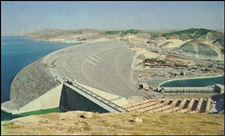 The primary objective of this model is to determine the optimal generating strategy for mixed hydrothermal electric power systems. The optimal operation strategy is obtained for the system as a whole, with an emphasis on detailed simulation and optimization of the hydro subsystem operation. The primary objective of this model is to determine the optimal generating strategy for mixed hydrothermal electric power systems. The optimal operation strategy is obtained for the system as a whole, with an emphasis on detailed simulation and optimization of the hydro subsystem operation.
PC VALORAGUA can simulate the operation of all types of hydropower plants (run-of-river, weekly, monthly, seasonal, or multiannual regulation), including pumped-storage plants and multipurpose hydro projects. The model calculates possible production by hydropower plants on the basis of either a historical series of monthly water inflows or synthetic water inflows with associated probabilities of occurrence.
This versatile model works with the hydraulic network of a country (or region) and can determine the optimal operation of up to 50 reservoirs in as many as 18 hydro-cascades in the system. The most outstanding feature of PC-VALORAGUA is that it can calculate the marginal value of water in reservoirs at all times of the year. The mathematical expectancy of the future value of water is the basis for deciding whether to use the water from the reservoirs now or to retain it for later use.
For more information about PC-VALORAGUA (Value of Water) Model, contact CEEESA.
Argonne Peak Shave Model (APS)
The APS model simulates hourly electricity generation from hydropower plants, thereby minimizing the maximum load on a utility’s thermal resources. The algorithm accounts for minimum flow requirements, maximum plant capacity, and up- and down-ramp rates. Peak loads are minimized over a user-specified time frame (i.e., day, week, month, or season).
For more information about Argonne Peak Shave Model (APS), contact CEEESA.
Argonne Load Flow Model (ALF)
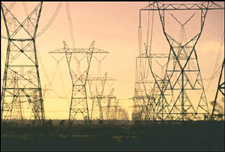 The ALF model simulates real and reactive power flow through individual lines and transformers, as well as voltage magnitudes and angles at all network nodes. The model helps predict the response of a system to changes in load, generation, and line reinforcements (or outages). The ALF model simulates real and reactive power flow through individual lines and transformers, as well as voltage magnitudes and angles at all network nodes. The model helps predict the response of a system to changes in load, generation, and line reinforcements (or outages).
ALF uses either the Fast Decoupled or the Newton-Raphson iterative technique to solve simultaneous node voltage equations that describe the network. The submodules for network reduction and for conversion into a DC model enhance the value of the model.
This PC-based system can handle up to 20,000 buses and 30,000 branches (lines and transformers).
For more information about Argonne Load Flow Model (ALF), contact CEEESA.
|

 The GTMax model helps researchers study complex marketing and system operational issues. With the aid of this comprehensive model, utility operators and managers can maximize the value of the electric system, taking into account not only its limited energy and transmission resources, but also firm contracts, independent power producer (IPP) agreements, and bulk power transaction opportunities on the spot market.
The GTMax model helps researchers study complex marketing and system operational issues. With the aid of this comprehensive model, utility operators and managers can maximize the value of the electric system, taking into account not only its limited energy and transmission resources, but also firm contracts, independent power producer (IPP) agreements, and bulk power transaction opportunities on the spot market. CEEESA's new EMCAS model is based on a novel agent-based simulation and modeling (ABMS) approach. ABMS allows analysts to represent the diverse set of participants in the electricity market as individual “agents.” All agents have their own set of objectives, decision-making rules, and behavioral patterns. Further, agents can draw on an array of historic information (e.g., past power prices) and projected data (e.g., next-day weather) to support their unique decision processes.
CEEESA's new EMCAS model is based on a novel agent-based simulation and modeling (ABMS) approach. ABMS allows analysts to represent the diverse set of participants in the electricity market as individual “agents.” All agents have their own set of objectives, decision-making rules, and behavioral patterns. Further, agents can draw on an array of historic information (e.g., past power prices) and projected data (e.g., next-day weather) to support their unique decision processes. The Power Market Simulator can be run in either a spreadsheet environment or within CEEESA's Generation-Transmission Maximization (
The Power Market Simulator can be run in either a spreadsheet environment or within CEEESA's Generation-Transmission Maximization ( Described as a strategic, scenario-based, simulation model, MAED performs long-term energy and electricity demand forecasting. Future energy demand is estimated by using a bottom-up approach in which useful energy demands for specific activities are projected. Energy consumption levels for individual activities are then aggregated to project total future demand for fossil fuels, electricity, district heating, coke, and feedstocks in each sector/subsector of the economy.
Described as a strategic, scenario-based, simulation model, MAED performs long-term energy and electricity demand forecasting. Future energy demand is estimated by using a bottom-up approach in which useful energy demands for specific activities are projected. Energy consumption levels for individual activities are then aggregated to project total future demand for fossil fuels, electricity, district heating, coke, and feedstocks in each sector/subsector of the economy. This widely used model analyzes generating system expansion options, primarily to determine the least costly expansion path that will adequately meet the demand for electric power, subject to user-defined constraints. To measure the economic performance of alternate expansion plans, WASP uses the present value of total system costs, including the capital cost of new generating units, fixed/variable operation and maintenance costs, fuel costs, and costs of unserved energy.
This widely used model analyzes generating system expansion options, primarily to determine the least costly expansion path that will adequately meet the demand for electric power, subject to user-defined constraints. To measure the economic performance of alternate expansion plans, WASP uses the present value of total system costs, including the capital cost of new generating units, fixed/variable operation and maintenance costs, fuel costs, and costs of unserved energy. Developed and distributed by the International Atomic Energy Agency, the DECADES software tools include the DECPAC model, which integrates electric system expansion planning with the analysis of primary energy supply chains and computes the resulting environmental emissions.
Developed and distributed by the International Atomic Energy Agency, the DECADES software tools include the DECPAC model, which integrates electric system expansion planning with the analysis of primary energy supply chains and computes the resulting environmental emissions. APEX integrates several modules that are used to evaluate production costs, reliability, transmission, and expansion alternatives for electric utilities. These modules are set up to transfer data among themselves. User‑friendly menu systems allow for information input and evaluation of results. Each of the APEX modules shown in the figure to the left is discussed below.
APEX integrates several modules that are used to evaluate production costs, reliability, transmission, and expansion alternatives for electric utilities. These modules are set up to transfer data among themselves. User‑friendly menu systems allow for information input and evaluation of results. Each of the APEX modules shown in the figure to the left is discussed below. The SMN multipurpose power network analysis tool can be used for a wide range of applications. At a relatively high level of aggregation (e.g., company level), the model determines the level of economic energy transactions between utility companies so that overall costs are minimized. At a finer level of detail (e.g., unit level), the SMN determines the optimal dispatch of units, while considering unit-level operational restrictions and transmission limitations.
The SMN multipurpose power network analysis tool can be used for a wide range of applications. At a relatively high level of aggregation (e.g., company level), the model determines the level of economic energy transactions between utility companies so that overall costs are minimized. At a finer level of detail (e.g., unit level), the SMN determines the optimal dispatch of units, while considering unit-level operational restrictions and transmission limitations. The primary objective of this model is to determine the optimal generating strategy for mixed hydrothermal electric power systems. The optimal operation strategy is obtained for the system as a whole, with an emphasis on detailed simulation and optimization of the hydro subsystem operation.
The primary objective of this model is to determine the optimal generating strategy for mixed hydrothermal electric power systems. The optimal operation strategy is obtained for the system as a whole, with an emphasis on detailed simulation and optimization of the hydro subsystem operation. The ALF model simulates real and reactive power flow through individual lines and transformers, as well as voltage magnitudes and angles at all network nodes. The model helps predict the response of a system to changes in load, generation, and line reinforcements (or outages).
The ALF model simulates real and reactive power flow through individual lines and transformers, as well as voltage magnitudes and angles at all network nodes. The model helps predict the response of a system to changes in load, generation, and line reinforcements (or outages).